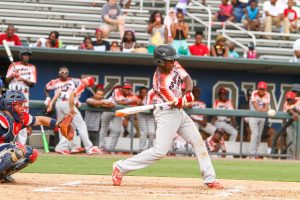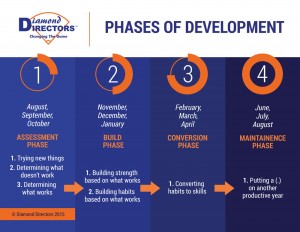As we approach fall baseball season, what kind of results would you like to have as a hitter in July 2016? Regardless of your answer, your success begins now.

Remember our breakdown of the hitting and learning cycles:
- August – October (Assessment Phase)
- November – January (Build Phase)
- February – April (Conversion Phase)
- May – July (Maintenance Phase)
Fall is your time to work on new stuff, determine what works and what doesn’t. Below are three takeaways you should put on your fall assessment to-do list. Before we get to them, let’s simplify hitting into seven fundamental parts.
- Stance/Load
- Timing
- Tempo
- Tracking
- Approach
- Contact
- Extension/Finish
Not sure I can make the swing any simpler than this. It takes 3,000 reps to build a habit. We can focus on building those habits in November. For now, let’s look at the three takeaways you should put on your fall assessment to do list.
Takeaway No. 1 – Small goals
I’d consider getting a hit 45 percent of the time for a .450 batting average this fall to be a big goal. In the fall, let’s focus on a small goal that can lead us to the big one.
Be on time at least 75 percent of the time. That’s a small goal that most hitters can’t master if their success as a hitter depended on it. I’m challenging you to be on time 75 percent of the time.
Remember – most Major League hitters make it happen 90 percent of the time.
Ask a coach, teammate or parent to video your next 25 at bats, which will help you determine how often you’re on time. Can you accomplish a small goal to be in time to track the pitch 75 percent of the time?
Why should you be on time anyway?
- To track pitches of varying types, speeds and locations
- To start and keep a short approach to the ball
- To make hard contact
- To maximize extension with a high finish to produce power
Is there another small goal you can accomplish that will lead to you having a productive at bat 50 percent of the time? Email it to me at askCJ@diamonddirectors.com.
 Takeaway No. 2 – Short practice
Takeaway No. 2 – Short practice
I wouldn’t consider myself to be an old school hitting coach. Those guys landed results and demanded their hitters take swings until their hands bled. Watching a hitter do that is worse than watching paint dry.
I challenge you to spend 10-15 minutes per day for four to five days per week developing the skill of timing. There is minimal equipment and time required. All that is needed is energy, discipline and deep focus.
Get a partner (younger sibling, teammate or grandparent) to complete the pitching delivery without throwing a ball.
Focus on timing your partners delivery in sets of 10 reps for a total of reps for the next 4-5 days.
- Above average fastball x 10 reps
- Average fastball x 10 reps
- Below average fastball x 10 reps
- Above average fastball x 10 reps
- Average fastball x 10 reps
- Below average fastball x 10 reps
- Above average fastball x 10 reps
- Average fastball x 10 reps
- Below average fastball x 10 reps
- Above average fastball x 10 reps
Tweet me a video to @atbats of your 500th timing rep. It won’t be easy to do.
Takeaway No. 3 – Specific outcomes
With a good small goal followed by short practices, you now can expect specific results. Mature hitters focus on the process of hitting in the fall, rather than the product (the hit). Productive at bats lead to hits so the outcome that you should focus on in the fall is to have a productive at bat 50 percent of your at bats.
- See at least six pitches regardless of the outcome
- Hit the ball hard regardless of the outcome
- Draw a walk
- Execute an offensive strategy such as a hit and run or advancing a runner
The difference between being ordinary and extraordinary is doing a little extra. New tagline. Let’s not use the old one. The difference between being ordinary and extraordinary is doing a little extra. New tagline. Let’s not use the old one.
Tip of the Month – Push Drill
Remember: Intelligence trumps being smart.
For more information, visit www.diamonddirectors.com today. Check out our second digital magazine.
BIO
C.J. Stewart has built a reputation as one of the leading professional hitting instructors in the country. He is a former professional baseball player in the Chicago Cubs organization and has also served as an area scout for the Cincinnati Reds. As founder and CEO of Diamond Directors Player Development, CJ has more than 12 years of player development experience and has built an impressive list of clients, including some of the top young prospects in baseball today. If your desire is to change your game for the better, C.J Stewart has a proven system of development and track record of success that can work for you.

Leave a Reply